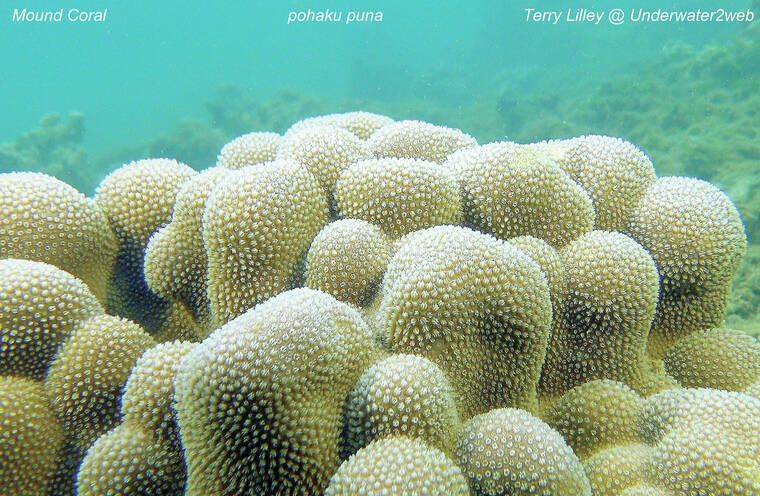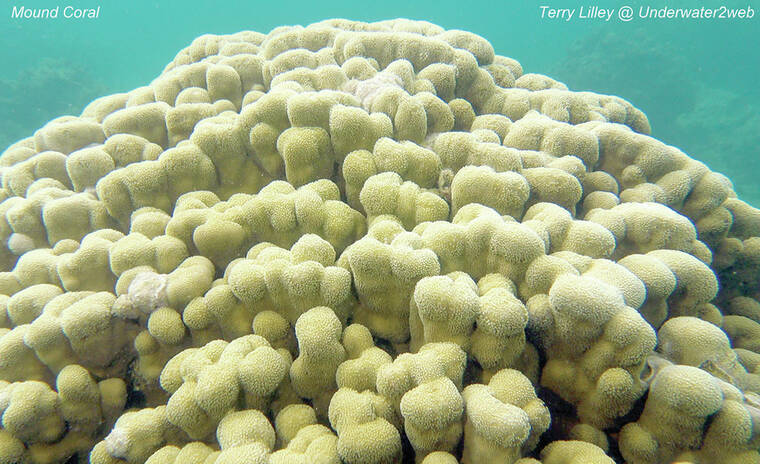Pohaku puna is our natural seawall here in Hawai‘i that helps protect our coastline from hurricane damage.
This coral grows in shallow water and can grow as large as a school bus and live for hundreds of years. The mound coral has rounded lobe-like structures and they are usually a tan or light purple color. Huge colonies of pohaku puna can be found in our shallow water calm bays and they are quite beautiful to look at. Some bays have purple colored mound corals and some have tan colored mound corals, and sometimes they grow side by side.
Hard stony corals like pohaku puna have a strong calcium carbonate structure, much like a condominium for people on land made of concrete. This rock hard structure houses thousands of soft individual coral polyps, much like a large condo will house many soft bodied humans. Pohaku puna can grow upward at over 5 inches a year and it is habitat for many marine life species.
In Hawai‘i we have a sea level rise of less than an inch a year and pohaku puna, if healthy, can grow faster than the sea level rise. This is super important because a reef covered in healthy mound corals will break up the energy of the surf caused by large storms and hurricanes before that energy hits the beach. If I had a house or business right on a Hawaiian beach I would want a lot of healthy pohaku puna growing out front to act as a natural seawall versus making a man-made concrete seawall that is sure to fall apart over time.
I just got back from a dive trip to Florida and got caught in the massive Ian hurricane. This hurricane wiped out thousands of homes and roads and was worse than it should have been because the coral reefs in Florida have died. Much of Florida 50 years ago was protected by outer reefs covered with elk horn coral, which broke up the energy of the storms. When the coral dies the reef lowers in height allowing the energy of the waves to hit the beach with more force destroying coastal homes.
The same thing is happening right now near Sunset Beach in O‘ahu where the pohaku puna has died over the past 10 years, and now there is an accelerated beach erosion and homes are falling into the sea. As a biologist, we call this “cause and effect.” Ten years ago along O‘ahu North Shore when I saw the corals starting to die, I did a news article saying the beach will start to erode away and we will lose some homes into the sea and sure enough it happened.
What can kill a 500-year-old car the size of pohaku puna? There are many human made conditions that can kill our coral reefs. Sewage leaks from cesspools and injection wells, toxic farm chemical runoff, mud runoff from improper coastal development, over tourism and underwater electrical discharge from military submarine activity have killed large areas of our coral reefs, which directly leads to more coastal erosion.
Pohaku puna can help save our coastline from sea level rise and more frequent large hurricanes if we would just study and take better care of our coral reefs.
You can see pohaku puna in living color in my YouTube marine life movies I shot in all the main Hawaiian Islands up at Underwater2web.
•••
Terry Lilley is a marine biologist living in Hanalei Kaua‘i and co-founder of Reef Guardians Hawai‘i, a nonprofit on a mission to provide education and resources to protect the coral reef. To donate to Reef Guardians Hawaii go to www.reefguardianshawaii.org.



